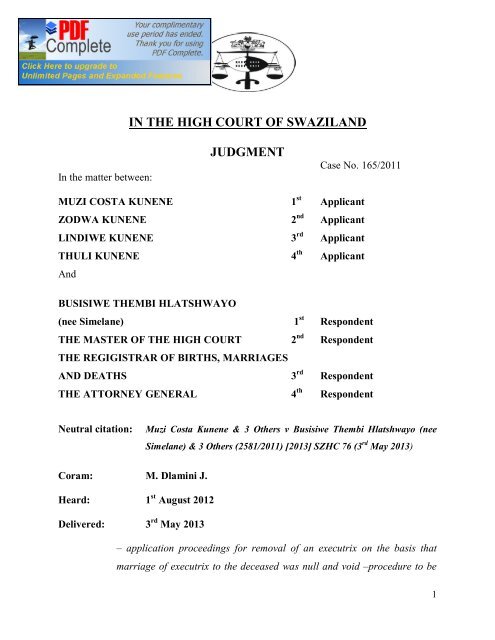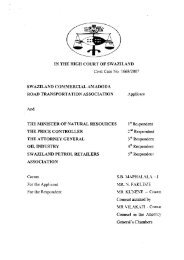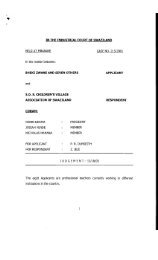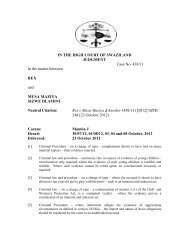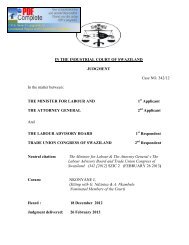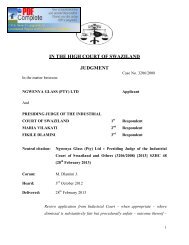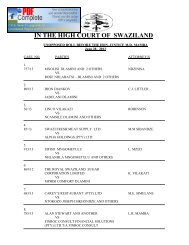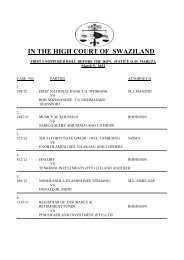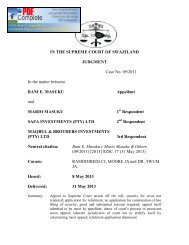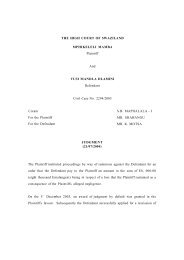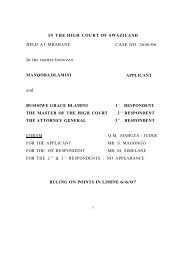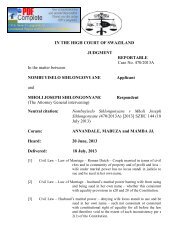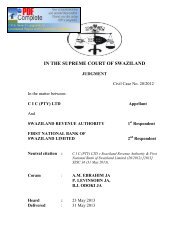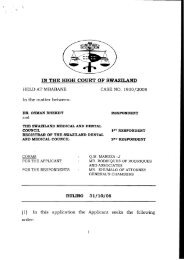MUZI COSTA KUNENE & 3 OTHERS V BUSISIWE T ... - SwaziLII
MUZI COSTA KUNENE & 3 OTHERS V BUSISIWE T ... - SwaziLII
MUZI COSTA KUNENE & 3 OTHERS V BUSISIWE T ... - SwaziLII
Create successful ePaper yourself
Turn your PDF publications into a flip-book with our unique Google optimized e-Paper software.
IN THE HIGH COURT OF SWAZILAND<br />
In the matter between:<br />
JUDGMENT<br />
Case No. 165/2011<br />
<strong>MUZI</strong> <strong>COSTA</strong> <strong>KUNENE</strong> 1 st Applicant<br />
ZODWA <strong>KUNENE</strong> 2 nd Applicant<br />
LINDIWE <strong>KUNENE</strong> 3 rd Applicant<br />
THULI <strong>KUNENE</strong> 4 th Applicant<br />
And<br />
<strong>BUSISIWE</strong> THEMBI HLATSHWAYO<br />
(nee Simelane) 1 st Respondent<br />
THE MASTER OF THE HIGH COURT 2 nd Respondent<br />
THE REGIGISTRAR OF BIRTHS, MARRIAGES<br />
AND DEATHS 3 rd Respondent<br />
THE ATTORNEY GENERAL 4 th Respondent<br />
Neutral citation:<br />
Muzi Costa Kunene & 3 Others v Busisiwe Thembi Hlatshwayo (nee<br />
Simelane) & 3 Others (2581/2011) [2013] SZHC 76 (3 rd May 2013)<br />
Coram: M. Dlamini J.<br />
Heard: 1 st August 2012<br />
Delivered: 3 rd May 2013<br />
– application proceedings for removal of an executrix on the basis that<br />
marriage of executrix to the deceased was null and void –procedure to be<br />
1
followed in dissolving Swazi law and custom marriage washing or<br />
cleansing off red ochre – and conditions necessitating washing off red<br />
ochre<br />
Summary: The applicants are beneficiaries of an estate where 1 st respondent was<br />
appointed as an executrix owing to a civil rites marriage between the<br />
executrix and the deceased. The applicants seek for orders declaring the<br />
said marriage null and void ab initio and consequently removal of 1 st<br />
respondent as an executrix. Their basis for having the said marriage null<br />
and void is that the 1 st respondent was married to a third party prior and that<br />
the said marriage had not been dissolved at the time of contracting the<br />
second marriage. The 1 st respondent vociferously contest the application on<br />
the ground that the said marriage with the third party was dissolved through<br />
the cleansing of red ochre ceremony. On the basis of this contention, the<br />
matter was referred to trial.<br />
[1] The applicants led six witnesses in proving their case.<br />
[2] The first witness, Tholiwe Ngozo on oath, informed the court that the 1 st<br />
respondent was her sister-in-law as she was married to her brother Dan<br />
Hlatshwayo by Swazi law and custom. She was present during the<br />
marriage ceremony in which the 1 st respondent was smeared with red ochre.<br />
Subsequently the special portion removed from the she-goat was sent to 1 st<br />
respondent parental home as a means of informing and confirming that 1 st<br />
respondent has been married under Swazi law and custom. She later, as<br />
custom would dictate, accompanied the 1 st respondent to her parental home.<br />
The 1 st respondent wore a pinafore, carried a spear and had a goat’s bile on<br />
her head, a gear indicative of a recently married woman being taken to her<br />
parental home. They found 1 st respondent’s mother who welcomed them.<br />
The said marriage took place on 4 th April 1998 and Belinah Ngozo smeared<br />
1 st respondent with red ochre. She stated that she never heard of any<br />
2
dissolution of this marriage between 1 st<br />
Hlatshwayo.<br />
respondent and the said Dan<br />
[3] The next witness was Belinah Ngozo, an elderly of seventy years old. She<br />
identified the 1 st respondent as her daughter-in-law who underwent Swazi<br />
law and custom marriage to Dan Hlatshwayo, her sister’s child. She<br />
confirmed smearing 1 st respondent with red ochre as stated by Tholiwe<br />
Ngozo. She also stated that she was not aware of any ceremony where the<br />
marriage between 1 st respondent and Hlatshwayo was dissolved. She<br />
informed the court further that she was aware that 1 st respondent was<br />
residing at Kunene’s family. Her evidence on the merits was not<br />
challenged under cross-examination.<br />
[4] The third witness was Muzi Costa Kunene, the 1 st applicant. His evidence<br />
on oath revealed that he was the son of the late Absalom Kunene who died<br />
on 19 th October 2010. After the death of his father, he saw a duplicate copy<br />
of a marriage certificate between his late father and the 1 st respondent. He<br />
was not aware that the two had contracted a civil rites marriage. Prior to<br />
the demise of his father, a delegation came from the Hlatshwayo<br />
homestead. The 1 st respondent was by then residing with his father at this<br />
witness’s parental home. When the delegation arrived, they met up with<br />
the 1 st respondent who chased it away. The reason for the delegation to<br />
proceed to his parental home was to fetch the 1 st respondent on the basis<br />
that she was a wife to the Hlatshwayos. Upon the death of his father and 1 st<br />
respondent having returned to her parental home, the Chief’s runner was<br />
dispatched to 1 st respondent’s parental home to inform the 1 st respondent<br />
and her relatives to report to the Kunene’s family on a specified date for a<br />
meeting between the Hlatshwayos, Kunenes and 1 st respondent’s family.<br />
The issue to be discussed was the reason for the 1 st respondent to reside at<br />
the Kunene family while lawfully wedded to the Hlatshwayos. This<br />
meeting never took place as 1 st respondent and her family did not turn up.<br />
3
[5] Under cross-examination, this witness was asked of an instance where his<br />
father invited him for a ceremony. He informed the court that there was<br />
never such instance. He revealed that he was not aware of how 1 st<br />
respondent came to reside with his father and that 1 st respondent resided<br />
with his father for a period of about nine months before his death. It was<br />
further his evidence under cross-examination that at the Master’s office,<br />
they were simply informed that 1 st respondent was the executrix. They<br />
were not given the opportunity to nominate an executor.<br />
[6] Selinah Ntombizodwa Kunene gave evidence similar to that of Muzi<br />
Kunene in relation to a delegation that came to her parental homestead from<br />
the Hlatshwayo family to demand for the return of their wife, the 1 st<br />
respondent. The delegation failed to get their wife as the very same wife<br />
chased them away before they could be seen by members of the Kunenes.<br />
Her father, Absalom Kunene was ill by then. It was her evidence that the<br />
delegation came again when her father had passed on and expressed shock<br />
on how they, the Kunenes, could allow their wife, 1 st respondent, to sit next<br />
to the corpse, being their deceased father, during the mourning ceremony.<br />
It was her evidence further that a meeting was called after the burial of her<br />
father but the 1 st respondent and her family failed to attend the meeting.<br />
[7] The next witness was Dan Hlatshwayo, who under oath informed the court<br />
that he married 1 st respondent in terms of Swazi law and custom in 1998<br />
and that the said marriage was never dissolved.<br />
[8] Under cross-examination his evidence was that he resided with 1 st<br />
respondent for a long time until 2009. He was aware that 1 st respondent<br />
lived as a lover with his uncle Absalom Kunene. He was about to confront<br />
his uncle about this matter but his uncle died shortly. He, however, had<br />
already sent a delegation to enquire on his behalf. He further revealed that<br />
4
he did not have a marriage certificate. It was under cross-examination that<br />
he still wanted his wife back and would be pleased to have her soon. He<br />
maintained sanctioning a delegation to the Kunene’s family to fetch his<br />
wife. He was not aware of any cleansing ceremony which dissolved their<br />
marriage.<br />
[9] The last witness was one Johan Mgcibelo Masuku who identified himself<br />
as the Chief’s runner of the area where the applicants and Dan Hlatshwayo<br />
reside since 1996. His evidence was that Dan Hlatshwayo married 1 st<br />
respondent under Swazi law and custom in 1998. No dissolution of this<br />
marriage was reported to the Chief’s kraal as custom would dictate. Under<br />
cross-examination, he stated that he was not aware of any ceremony<br />
between the 1 st respondent and Absalom Kunene – although he was aware<br />
that they cohabited together. It was his evidence that even if a report to the<br />
Chief’s kraal would be made, he would eventually receive the report as all<br />
reports must reach him.<br />
[10] Three witnesses attended court on behalf of 1 st respondent.<br />
[11] The 1 st respondent gave evidence under oath. She stated that she was<br />
married to Absalom Arthur Mshengu Kunene, the father of applicants in<br />
terms of civil rites. She handed the marriage certificate and was marked as<br />
exhibit “DC 1”. There were no children born out of the said marriage. It<br />
was her evidence further that she was introduced to the applicants by<br />
Absalom Kunene. She revealed that before the said marriage, she had<br />
contracted a marriage in terms of Swazi law and custom with Dan<br />
Hlatshwayo. After a long time, she separated from Dan Hlatshwayo.<br />
When she had a relationship with Absalom Kunene, her parents informed<br />
the said Mr. Kunene that she was married under Swazi law and custom.<br />
They suggested to Mr. Kunene that a goat must be purchased in order to<br />
cleanse the red ochre upon her. This was done. This was reported to the<br />
5
Chief’s kraal to PW6, Johan Masuku. After the cleansing ceremony, Mr.<br />
Kunene sent a delegation to ask for her hand in marriage. She lived with<br />
Mr. Kunene for a period of six to seven months before they were married.<br />
She was, however, chased by Mr. Kunene’s children and relatives after Mr.<br />
Kunene’s death. Before his demise, she lived peacefully with Mr.<br />
Kunene’s family. She denied ever chasing a delegation from Hlatshwayo’s<br />
homestead. The marriage between Mr. Kunene and herself was known to<br />
the community. The applicants knew about her civil rites marriage as Mr.<br />
Absalom Kunene informed them of the marriage. It was her evidence<br />
further that there was never any delegation from Hlatshwayo to fetch her<br />
before or after the death of Mr. Kunene.<br />
[12] Under cross-examination, she revealed that only members of her family<br />
were present when the cleansing of red ochre was performed upon her. In<br />
her re-examination she confirmed that she was summoned to attend to a<br />
meeting where they would discuss her marriage to Mr. Hlatshwayo. She<br />
never attended because the Kunenes who summoned here were in a fighting<br />
mood.<br />
[13] The next witness was Sibongile Eunice Mavimbela. This is the biological<br />
mother of 1 st respondent who informed the court that her daughter was<br />
married under Swazi law and custom to the Hlatshwayos. Subsequently a<br />
delegation came to ask for her hand in marriage. It was suggested that she<br />
should be cleansed of the red ochre. A goat was slaughtered, mixed its<br />
blood with dung and she was cleansed with the concoction. Her evidence<br />
that Mr. Hlatshwayo’s uncle, one Mr. Mdluli, was informed of the<br />
cleansing. Later, Mr. Kunene wedded 1 st respondent in the presence of two<br />
of his sisters at Nhlangano District Commissioner’s offices. Upon the<br />
death of Mr. Kunene, they went for mourning. The following day 2 nd<br />
applicant chased them away with 1 st respondent.<br />
6
[14] This witness was cross-examined on whether she did at some point<br />
consider her daughter to be married to Dan Hlatshwayo. Her response was<br />
that 1 st respondent was never married to the Hlatshwayo because marriage<br />
in terms of Swazi law and custom consisted of smearing with red ochre<br />
(kutekwa), payment of bride prize (kulobola) and dancing of bridal party<br />
(kugidza umtsimba). In the absence of any one of these, the woman cannot<br />
be held to be lawfully married, according to this witness.<br />
Legal principles<br />
[15] The question for determination is whether the 1 st respondent was married to<br />
one Dan Hlatshwayo. If the answer is yes, the next question is whether the<br />
said marriage was dissolved so as to qualify the 1 st respondent to remarry to<br />
another man.<br />
[16] Our jurisdiction recognizes two types of marriages viz. civil or common law<br />
marriage and Swazi law and custom marriage. This can clearly be deduced<br />
from section 7 (1) of the marriage Act No.47 of 1964.<br />
“7. (1) No person already legally married may marry in terms of this<br />
Act during the subsistence of the marriage, irrespective of<br />
whether that previous marriage was in accordance with Swazi<br />
law and custom or civil rites and any person who purports to<br />
enter into such a marriage shall be deemed to have committed<br />
the offence of bigamy:<br />
Provided that nothing contained in this section shall prevent<br />
parties married in accordance with Swazi law and custom or<br />
other rites from re-marrying one another in terms of this Act.”<br />
7
[17] His Lordship M. C. B. Maphalala J. in Siphiwe Magagula v Lindiwe<br />
Mabuza 4577/08 at page 8 writes:<br />
“There are two forms of marriages recognized in Swaziland: it is the<br />
marriage by Swazi Law and Custom and marriage by civil rites”<br />
[18] Thandabantu Nhlapho, Marriage and Divorce in Swazi Law and<br />
Custom, page 75 writes:<br />
“…the characteristic features of Swazi marriage are libovu (red ochre),<br />
lobolo and procreation.”<br />
[19] M. C. B. Maphalala J. in the case of Siphiwe Magagula v Lindiwe<br />
Mabuza and Others 4577/08 at page 7 on the question on the procedure<br />
which constitute Swazi law and custom cites his Lordship Chief Justice<br />
Nathan in R. v Fakudze and Another 1970-1976 S. L. R. 422 at 423 as<br />
follows:<br />
“There are a number of ceremonies performed at the wedding, but the<br />
legally significant one is the anointing of the bride with red-ochre<br />
(libovu). Unless and until this has been done, she is not regarded as<br />
having been married.<br />
[20] The learned Judge continues to quote R. v Timothy Mabuza 1979-1981 S.<br />
L. R. 8 at 9:<br />
“…the smearing with red-ochre was an essential part of a Swazi marriage<br />
ceremony….. it is usually done outside the cattle byre but at the upper end<br />
of the cattle byre, that is immediately below the main hut….even if the<br />
smearing was not done at the proper place the person smeared in the<br />
8
circumstance of this case would be considered as a married woman, and<br />
this would be so even if no lobola at all has been paid …” (my emphasis)<br />
[21] The honourable Judge then wisely concludes at paragraph 10:<br />
“It is common cause that the first respondent was married to the deceased<br />
in terms of Swazi law and custom and, she was smeared with red ochre<br />
which is the essential requirement of a Swazi marriage ceremony.” (my<br />
emphasis)<br />
[22] In casu, the applicants and 1 st respondent are at ad idem that the 1 st<br />
respondent was smeared with red ochre. The evidence shows that the 1 st<br />
respondent cohabited with the said Dan Hlatshwayo for a considerably long<br />
period before she was smeared with red-ochre. It is understandably on that<br />
basis that there were no allegations of “forcibly smearing”. From the<br />
preceding authorities it is clear that the 1 st respondent therefore became<br />
wife upon smearing with red ochre.<br />
[23] That there was no subsequent lobola or dowry paid is inconsequential to the<br />
question of the validity of the marriage. For the said reason I find that the<br />
1 st respondent was a wife to the said Dan Hlatshwayo.<br />
[24] The second question is whether there was a dissolution of the said marriage<br />
by virtue of the cleansing ceremony that was performed upon 1 st respondent<br />
before she contracted the civil rites marriage with the deceased.<br />
[25] The learned author, Thandabantu Nhlapho, supra at page 77 states on the<br />
subject of divorce under Swazi law and custom:<br />
9
“The Swazis have an almost illimitable capacity for compromise, and it<br />
will only be in the most stubborn cases where there is grievous cause for<br />
complaint that the separation will be effected”<br />
[26] He propounds further at page 53:<br />
“At any rate there is agreement that adultery and witchcraft are grounds<br />
for divorce at the instance of the husband (but not of the wife) in custom.<br />
Neglect of duty, desertion and/or gross ill treatment by a husband appear<br />
to be the only grounds available to a wife to end a customary marriage.”<br />
[27] In casu the 1 st respondent has not alleged any of the grounds stated by<br />
Nhlapho which are available to her to precipitate divorce under Swazi law<br />
and custom. All she states is that the deceased wanted to marry her and<br />
upon discovery that she was married to Dan Hlatshwayo it was suggested<br />
that there should be “washing off the red ochre” as Nhlapho refers to the<br />
cleansing ceremony.<br />
[28] In order to ascertain the effects of the washing off red ochre, this court<br />
invited as a witness who was an expert in Swazi law and custom, one Mr.<br />
Msweli Mdluli. Mr. Mdluli sits at Nhlangano Swazi Court as an assessor.<br />
He informed the court that in the cleansing of red ochre, the parent of the<br />
woman who has been smeared with red ochre, sends a cow to the family<br />
which smeared the daughter with red ochre. This procedure is not available<br />
to one who upon smearing with red ochre assumed and discharged duties as<br />
a wife. It is, I may add, done in instances where the special goat portion<br />
(umsasane) has not been accepted by the woman’s family from the onset.<br />
This practice according to Mr. Mdluli, is carried out where the “husband” is<br />
considered by the family and community general as a lunatic (luhlanya).<br />
Lunatic, in the sense that by his conduct, the man cannot be viewed as<br />
10
having any serious intention or capabilities of establishing a concrete<br />
relationship with a woman.<br />
[29] Mr. Nhlapho, op. cit. at page 92 on the washing off the red ochre writes on<br />
when and how this process could be evoked:<br />
“A forcibly smears X but does not pay lobolo. B comes along and offers<br />
X’s parents lobolo for her. They accept the cattle and pay one to A’s<br />
family to clean off the red ochre. Then when X is subsequently smeared<br />
with liphehla (animal fat) at B’s place it has more weight – but she cannot<br />
bear the heir.”<br />
[308] From the above, it is clear that the learned author yet defines another<br />
scenario where cleansing of red-ochre can take place.<br />
[31] However, what is common between Mr. Nhlapho and Mr. Mdluli’s<br />
explanation is the procedure that the family of the girl has to send a cow to<br />
the family where the girl was smeared with red ochre.<br />
[32] In casu, it is clear that although the 1 st respondent sought to cleanse herself<br />
off the red-ochre, the appropriate procedure was not followed. All they did,<br />
according to 1 st respondent and her witnesses, was to wash her with the<br />
goat’s concoction of dung and blood. The family of Dan Hlatshwayo were<br />
never informed. This is clearly demonstrated by Dan Hlatshwayo who in<br />
his evidence revealed that he sent a delegation before and after the death of<br />
Absalom Kunene to demand for his wife, 1 st respondent. In fact, the said<br />
Dan Hlatshwayo adamantly informed this court that he still wanted his wife<br />
back.<br />
[33] In the result, the red ochre was not cleansed.<br />
11
[34] I am very much aware of the dictum in Siphiwe Magagula op. cit. at page<br />
10 where his Lordship M. C. B. Maphalala J. states:<br />
“where the wife deserts her husband and marries another man during the<br />
lifetime of the husband, the marriage automatically comes to an end<br />
whether or not a family meeting is held; she cannot be said to be still<br />
legally married to the first husband.”<br />
[35] I agree with the learned judge on the above laid down principle. However,<br />
it is trite law that there are exceptions to every general rule and that each<br />
case should be determined according to its own peculiar circumstances.<br />
The Siphiwe Magagula and the present case’s circumstances are very<br />
much distinguishable.<br />
[36] In Siphiwe Magagula’s case the applicant had been married to the<br />
deceased before contracting another marriage with a different man. The<br />
second man died. She became the beneficiary. Later the first husband<br />
died. She proceeded to lay a claim against the estate of the first husband. It<br />
is upon this basis that the honourable court correctly held that the marriage<br />
was dissolved when she was married to the second man.<br />
[37] In casu, the first husband, Dan Hlatshwayo has sent delegations on various<br />
occasions calling upon the return of his wife. While in the Siphiwe’s case<br />
no allegations that the first husband persisted in having his wife returned.<br />
In other words, in Siphiwe Magagula’s case there was tacit agreement<br />
between the parties to have the marriage contract terminated while in casu<br />
the sending of delegation within a short space of time, being nine months,<br />
clearly demonstrate that the other party was contesting the end of the<br />
marriage.<br />
12
[38] Smit J. A. in Dladla v Dlamini 1977-1978 S. L. R. 15 at 16 clarifies:<br />
“A marriage in terms of Swazi law is not dissolved by a subsequent<br />
marriage in terms of statute law…. The customary law marriage is a valid<br />
marriage contract when entered into and there is no law which provides<br />
for its dissolution when it is followed by a civil rites marriage.”<br />
[39] In the premises I find that the marriage between 1 st respondent and Mr. Dan<br />
Hlatshwayo still subsists. The marriage therefore between 1 st respondent<br />
and Mr. Absalom Kunene is invalid and therefore void ab initio.<br />
.<br />
[40] Without necessarily setting a precedent, I am not inclined to grant the<br />
applicants costs of suit for the reason that 1 st respondent believed that the<br />
procedure taken was not irregular in cleansing of red ochre and therefore<br />
was justified in defending the matter.<br />
[41] In light of the aforegoing I make the following orders:<br />
1. The marriage between the 1 st respondent and Absalom Arthur<br />
Mshengu Kunene is hereby declared null and void ab initio;<br />
2. 1 st respondent is hereby removed from being the executrix of the<br />
estate of the late Absalom Arthur Mshengu Kunene under file ES<br />
133/2010;<br />
3. Letters of Administration given to 1 st respondent by 2 nd respondent<br />
are hereby cancelled;<br />
4. The 3 rd respondent is hereby ordered to:<br />
13
4.1 cancel the marriage certificate number 18794 issued in favour<br />
of 1 st respondent;<br />
4.2 Expunge from its registry the entry under certificate number<br />
18794;<br />
5. Each party to bear his or her own costs.<br />
_______________________<br />
M. DLAMINI<br />
JUDGE<br />
For Applicants : Mr. M. Dlamini<br />
For Respondents : Mr. M. E. Nkambule<br />
14


